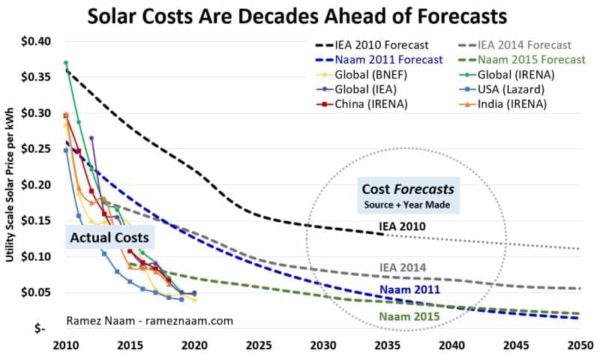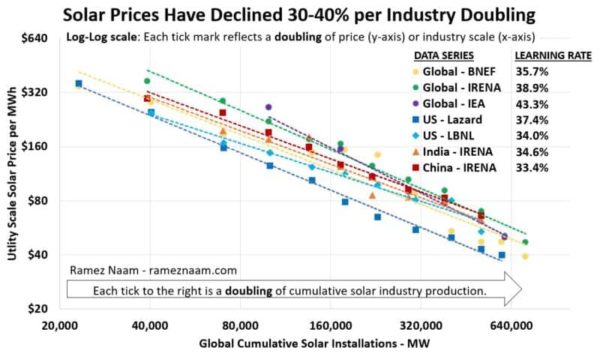The pace of solar cost declines will bring average prices in “reasonably sunny” parts of the world down to a penny or two per kilowatt-hour by 2030 or 2035, according to new research by Ramez Naam, a clean energy investor and expert in disruptive energy technologies.
This would mean that building new solar would be routinely cheaper than operating already-built fossil fuel plants, even in today’s world of ultra-cheap natural gas.
“Solar has plunged in price faster than anyone – including me – predicted. And modeling of that price decline leads me to forecast that solar will continue to drop in price faster than I’ve previously expected, and [it] will ultimately reach prices lower than virtually anyone expected. Prices that are, by any stretch of the measure, insanely, world-changingly cheap,” Naam said.
From 2010 to 2020, the price of electricity from utility-scale solar projects dropped by a factor of somewhere between five and eight, Naam pointed out. His analysis looked at metrics of average cost of (unsubsidized) projects that were built since 2010 and averages of bids for projects scheduled to come online in 2020.
Solar prices drop through learning
“Every time the cumulative amount of solar we’ve deployed around the world has doubled, the price of electricity from utility-scale solar plants has dropped by a fairly consistent percentage,” Naam noted. In his analysis, he referred to Wright’s Law, which says that this learning-by-doing phenomenon happens because of a mixture of innovation that improves the technology itself and innovation that reduces the amount of labor, time, energy and raw materials needed to produce the technology.

It’s well established that Wright’s Law applies to the cost of solar modules, the price of which per-watt-of-power typically drops by about 25% for every doubling of cumulative manufacturing, Naam said. Yet because solar modules only represent about a third of the cost of solar electricity, Naam looked at whether the cost of electricity from entire solar systems drops in such a way.
To do this, he used data from four different sources encompassing both global average and costs in three countries (the U.S., India and China).
According to his research, the price of solar electricity from utility-scale solar systems drops about 305 to 40% with each doubling of cumulative solar deployment. Using the more conservative 30% learning per doubling rate to plot solar prices forward as a function of cumulative solar scale, the pace of solar declines should get to a penny or two in the next 10 to 15 years, he said.
History of outshining forecasts
In his analysis, Naam pointed out that solar costs are already 30 to 40 years ahead of the International Energy Agency’s (IEA) forecast in its 2014 Solar Technology Roadmap and 7 to 10 years ahead of his own ambitious forecast in 2015, which only used data from one source, Lawrence Berkeley Lab, and one country, the U.S. For its part, the IEA says that it doesn’t publish forecasts, it publishes scenarios of what would happen if the world failed to enact further energy policies.
“While it’s clear that new policies have made a difference in deployment, it’s also clear that, whatever you expect in terms of global energy policies, cost is a massively important fact,” Naam said. “You can’t expect to forecast the growth of a technology, if you consistently expect it to cost two to four times what it does,” he added.
Naam sees solar is an incredible tool for decarbonizing the electrical grid, but he thinks that it needs to be combined with other clean energy technologies and energy storage to have its greatest impact in decarbonizing society.

This content is protected by copyright and may not be reused. If you want to cooperate with us and would like to reuse some of our content, please contact: editors@pv-magazine.com.








““Solar has plunged in price faster than anyone – including me – predicted. And modeling of that price decline leads me to forecast that solar will continue to drop in price faster than I’ve previously expected, and [it] will ultimately reach prices lower than virtually anyone expected. Prices that are, by any stretch of the measure, insanely, world-changingly cheap,” Naam said.””
Nuclear couldn’t meet the claim of : “Too cheap to meter”, but solar PV will sooner or later.
“According to his research, the price of solar electricity from utility-scale solar systems drops about 305 to 40% with each doubling of cumulative solar deployment. Using the more conservative 30% learning per doubling rate to plot solar prices forward as a function of cumulative solar scale, the pace of solar declines should get to a penny or two in the next 10 to 15 years, he said.”
So, what happens if the tandem solar PV panel arrives at a solar harvest efficiency of 30% to 35%? What does this do to Wright’s Law? With that generation ability on one’s roof, it is 10% to 15% more efficient than the utility grid. Large solar PV arrays on roofs and large behind the meter residential energy storage systems would be the normal.
This is why Oil Companies with 99 year leases on land that used to have Oil extraction are installing Solar Farms over the depleated oil fields as they still have 50 years or more on the leases. with Sates, like California Mandating renewables, the going rate that utilities must purchase that required power for is $ .08 per kilowatt hour. That is a 400% profit on a generation cost of $.02. State mandates are driving up prices on renewables but those higher prices and profits are driving an industry faster reducing the per unit cost of constructing them. Eventually, with so much competition, the market forces will take over and energy production to market cost will come down. Distribution is another matter. PG&E now charges $.20 per kilo watt hour just to deliver the energy to your home or business.outside the cost of the energy inself. My off grid system costs me $.15 per kilo watt hour for everything. Solar panels, mointings, wireing, charge controlers, pure sine wave inverters and batteries (that must be replaced every 7 years). over a 25 year depreciated life.
I read Ramez Naam’s post a couple of days ago. Good info, but I think he again is too conservative.
Also saw the article on utilitydive about 100MW solar in New Mexico and 100MW solar+storage that already hit that mark:
“The projects were proposed to serve southern New Mexico and west Texas customers, and start service in the summer of 2022. One project will add 100 MW of solar for $0.015 per kWh while the second will add 100 MW of solar and 50 MW of storage for $0.021 per kWh, record-low prices for solar and storage in New Mexico.”
Actually, I predicted these kinds of prices in my 2015 book Solar: Why Our Energy Future Is So Bright, based on simple extrapolations of recent growth and price trends (a la Swanson’s Law). Here’s the summary from 2015, followed by annual updates on my “solar singularity” concept.
I wrote in this piece: “Making predictions (especially about the future) is difficult, because there is no guarantee, of course, that the past is a reliable guide to the future. However, when it comes to solar power, we see the very clear trend of price reductions continuing for some time, because there are no inherent limits to further reductions. Jeremy Rifkin has made the case that solar panels will become practically free with zero marginal cost for production in his book The Zero Marginal Cost Society. As we’ll see below, this is a reasonable prediction.”
“Under this trend, we can expect by 2020, under a 30 percent global rate of growth, to see total solar costs for utility-scale systems at around $0.84 per watt, based on GTM Research’s projected $1.10 per watt for 2017. By 2025, the cost drops to about $0.54 per watt, and by 2030 it will be a practically free cost of $0.34 per watt. By 2040, we can expect under these trends to see costs at about 14 cents per watt. A 5-kilowatt home-size system would cost only $700.”
https://www.greentechmedia.com/articles/read/The-Solar-Singularity-is-Nigh
As one reaches $.025/kwh it gets increasingly hard to get under that as other than the solar system electronics, BoS costs stay the same, increase even.
I expect to sell solar generators next yr after tariffs are gone for $1/wt which equates to about $.05/kwh. But solar parts are only 50% of that cost.
So if solar parts cut by 50% to $.10/wt panels/ inverters world price, it will only reduce costs 25% down to $.04/kwh no subsidies..
Most of those saying less have various subsidies like land, no cost financing, rebates, etc allowing it.
Or thinking by the time they build it, prices will have dropped which happened on a couple of $.02/kwh bids that were refused as not viable but still touted.
Kind of like how they convince themselves grid batteries are viable in a well run grid.
The concept of “green” industry has been flailed around for at least 15 years now. I’m beginning to see large energy use industrial and manufacturing entities around the World, tap into renewable energy as a personal power supply. Australia seems to be on a “run” right now to install micro-grids near service areas to power things like public transportation. In remote regions, mining operations and large agricultural operations are going solar PV, wind and either energy storage or heat storage of solar PV and wind for the operations.
If a manufacturer uses non-fueled generation with energy storage to produce a product, just how low can the total manufacturing costs go, when energy used is taken out of the equation? If a recycling plant uses alternative energy and energy storage to run their operation, how much more waste product can be recycled because it is cheap to sort, grind up and package more types of plastics to reuse in manufacturing products? The two largest cost adders to manufacturing is “human labor” and energy costs. We have witnessed the automation of plants all over the World since the 1970’s. Now it is time to use alternative energy to drive the manufacturing process and deal with the “other” recurring cost to manufacturing lines around the World.